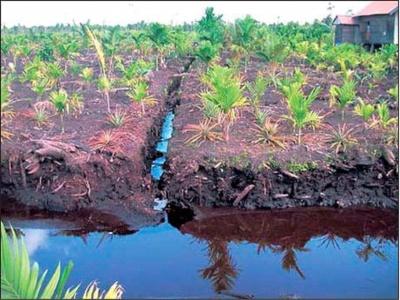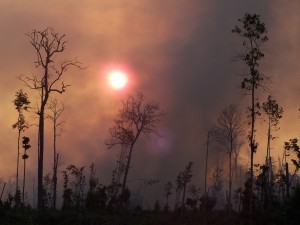The pickle with peat

Research shows that six per cent of global man-made carbon emissions is attributable to ‘reclaimed’ bogs. Yet international climate conventions ignore peatland as a cause of global warming. The case for peatland's inclusion in the next climate protocol (being negotiated in Copenhagen next month) was made at a recent lecture organised by the Environmental Protection Agency. By Malachy Browne.
Peat is found almost anywhere – from the boreal tundra to the tropics, from high in mountain ranges to beneath the sea, in Ireland, Indonesia and Kenya. In fact, peatland is found with varying incidence in almost every country and accounts for three per cent of the world’s land surface. Yet most people associate peatland with turf fires, peat moss and energy; a few might associate it with nature conservation.
Professor Hans Joosten, an expert in bogs and climate change, describes our ignorance of peat as the “Cinderella syndrome” – something very important but hardly ever noticed. Indeed, peatland, which contains twice as much carbon as the world’s forest stock and three quarters of the entire carbon in the atmosphere, is currently excluded from the metrics of international climate conventions.
Professor Joosten has long studied the carbon emissions arising from so-called ‘reclaimed’ peatland. Essentially, this is bogland which has been drained of its natural water content. Carbon emissions are produced as the land reacts with air, emitting carbon dioxide (CO2).
Results show that such ‘degraded’ peatland, as Hans Joosten more appropriately calls it, is responsible for six per cent of the atmosphere’s anthropogenic (man-made) carbon dioxide, or two gigaton of CO2 per year. Smaller amounts of nitrogen oxide (NO2), a far more powerful greenhouse gas, are also produced.
Most of the emissions from degraded peatland arise through agricultural land use. As human populations have grown, food demand has caused intensive agriculture on both dryland and peatland. “Natural peatlands are always wetlands,” explains Joosten, “and it is the water-logging that allows the sequestration and long term storage of carbon dioxide.”
“Peatland agriculture imitates dryland agriculture, although draining, tilling and fertilizing are the most effective ways to enhance peat oxidation and degradation” says Joosten. Drainage also causes peatland to subside, often to the extent that proximity to the water table requires deeper drainage, which lowers the peatland more, and so on, in what he terms a “Devil’s cycle”.
“I myself come from the Netherlands where we managed in 1,000 years of peatland drainage to lower the country so much that half the country now lies below sea level. The windmills are well known from the Netherlands – it is equipment to pump peatlands dry that have become too low due to subsidence from peatland drainage. This is going on in large parts of the world”.
The obliteration of New Orleans by flood water following Hurricane Katrina in 2005 was a direct consequence of this. The city was originally situated on peatland and drained so much that the land surface was lowered to five metres below sea level, inviting the sea to flood. “This was a peatland problem, not climate problem,” says Joosten.
 Driven mostly by western consumerism, peatland is increasingly degraded for agricultural purposes. In the tropics, desert plants like aloe vera are cultivated on degraded peatland; in Europe, dryland species like maize are cultivated on peatland which should be wet. In 1997, fires deliberately set after the illegal deforestation of reclaimed peatland in the Indonesian island Kalimantan caused the largest increase in CO2 concentrations on earth since the measurements began in 1957. Today, the area is completely covered by smoke for six months of the year – poor visibility sometimes prevents airplanes from landing.
Driven mostly by western consumerism, peatland is increasingly degraded for agricultural purposes. In the tropics, desert plants like aloe vera are cultivated on degraded peatland; in Europe, dryland species like maize are cultivated on peatland which should be wet. In 1997, fires deliberately set after the illegal deforestation of reclaimed peatland in the Indonesian island Kalimantan caused the largest increase in CO2 concentrations on earth since the measurements began in 1957. Today, the area is completely covered by smoke for six months of the year – poor visibility sometimes prevents airplanes from landing.
The challenge now is twofold: to rewet degraded peatland and to include CO2 emissions from peatland as a metric in the next climate protocol. Rewetting is underway in some parts of the world. In Copenhagen this December, governments will negotiate a successor to the Kyoto Protocol which expires in 2012. It is Professor Joosten’s hope to have peatland included in the next protocol. He is uncertain of the chances – vested interests may be too strong.
Peatlands – the vital statistics:
- Peatland spans three per cent of the world’s land surface, or four million sq km worldwide
- Peatland from the boreal zone contains seven times more carbon per hectare than other ecosystems; tropical peatland contains 10 times more
- Global peatland stocks contain 500 gigaton of carbon, twice the amount of carbon in the world’s entire forest stock
- Degraded peatlands emit over two gigaton of carbon dioxide (C02) every year; this accounts for 6 per cent of all anthropogenic (or man-made) CO2 emissions
- These emissions arise from only a fraction of worldwide peatland, equating to 0.3% of the Earth’s land surface
Professor Joosten’s lecture was part of the “Road to Copenhagen” lecture series organised by the Environmental Protection Agency.
The next debate, Back to the Future – The Role of Climate Science will be presented by Professor Jean-Pascal van Ypersele, Head of Climatology and Environmental Sciences, University Catholique de Louvain. The lecture will take place on Tuesday 24 November, 2009 at the Mansion House.
Attendance is free, but advance booking is essential. To book, you should contact Clara Clark Event Management on 01 2898533 or email info@claraclark.ie.
